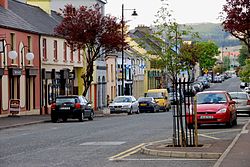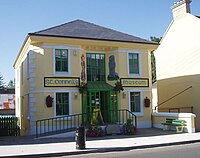Glenties
| Glenties Irish: Na Gleannta | |
| County Donegal | |
|---|---|

| |
| Location | |
| Grid reference: | G818944 |
| Location: | 54°47’51"N, 8°16’57"W |
| Data | |
| Population: | 805 (2016) |
| Local Government | |
| Dáil constituency: |
Donegal |
Glenties s a town in County Donegal. It is situated where two glens meet, north-west of the Bluestack Mountains, near the confluence of two rivers. Glenties is the largest centre of population in the parish of Iniskeel.
The village's name in Gaelic is Na Gleannta, meaning 'The glens'.[1]
Contents
History
Evidence of early settlement in the area is given by the many dolmens, standing stones and earthen ringforts dating from the Bronze Age. The area became part of the Baronies of Boylagh and Bannagh in 1609, which was granted to Scottish undertakers as part of the Plantation of Ulster.
Glenties was a regular stopping point on the road between the established towns of Ballybofey and Killybegs, and grew from this in the 17th and 18th centuries. The town was developed as a summer home for the Marquess Conyngham in the 1820s, because of its good hunting and fishing areas. The court house and market house were built in 1843. The Bank of Ireland building was completed in 1880.[2]
Famine in Glenties
A workhouse was built during Great Famine (Ireland)|the Famine at the site of the current Comprehensive School in 1846, serving the greater Inniskeel area. A 40-bed Fever Hospital was later added to care for the sick and dying. The landlord, the Marquis of Conyngham, decided to halve the population of the town in 1847, faced by the rising costs of the workhouse. Only those who could show title to their land as rent payers were allowed to remain: the rest were given an option of going to America on a ship provided or entering the Workhouse in Glenties.
20th century
The railway was completed in 1895 from Ballybofey. In 1903 a local water scheme was established, to be replaced in 1925 by the current Lough Anna supply. In 1932 electricity was first generated locally in the town. Rural electrification came in the 1950s.
Glenties Royal Irish Constabulary barracks was attacked on numerous occasions during the Irish War of Independence in 1920/1921. On 29 June 1921, a group of Black and Tans were ambushed on their way to Ardara at Kilraine by the insurgents, resulting in the death of a Constable Devine.
Two Free State]] soldiers were killed at Lacklea in 1922 by the Irish Republican Army forces, during the Irish Civil War.
In January 1944, a British RAF Sunderland Mark III flying boat crashed in the Croaghs area of the Bluestack Mountains, outside of Glenties, killing seven of its 12-man crew.
Bord na Móna
Bord na Móna (@) bought 1,200 acres of bog in 1937 to be drained and cut for peat. By 1943 a railway had been extended from Kilraine across the Owenea River to the bogs at Tullyard. Machine cutting commenced in 1946, utilising German-made cutting machines. The company employed 250 men in peak season and peak production was 22,000 tons in 1965. Operations ceased in the late 1990s and the railways and stock were lifted in 2006.
Around the town
Glenties is situated at the meeting of two glens, and two rivers; the Owenea and Stranaglough.
One of its most striking buildings is its unusual church, St Connell's, which was built in 1974 to replace the old church. The building has a flat roof sloping to the ground at a sharp angle. The original bell from the first church is still used today in the newer church. St. Connell is the patron saint of the parish. Liam McCormack won a European Award for its design in 1974.
A memorial to the 'Navvy Poet', Patrick MacGill, who was born in Glenties, is located on the bridge over the river in the centre of town.
St Connell's Museum and Heritage Centre has a good collection of local history artefacts, including some from the famine. The museum is named after St Connell Caol, who founded a monastic settlement on Inishkeel Island in the 6th century. The museum also has mementoes from the filming of Dancing at Lughnasa, and an extensive display about the County Donegal Railways Joint Committee. It also has a reading room with a good collection of local historic records.
Sport
- Gaelic games: Naomh Conaill CLCG
In popular culture
Glenties was the model for Brian Friel's fictional village of Ballybeg, where several of his works were set. His play Dancing at Lughnasa was set in Ballybeg and was made into a film in 1994 starring Meryl Streep.
Outside links
| ("Wikimedia Commons" has material about Glenties) |
References
- ↑ Na Gleannta / Glenties: Placenames Database of Ireland
- ↑ Briody, Liam (1986). Glenties and Inniskeel – A Study of Glenties Town and Inniskeel Parish. Donegal Democrat Ltd..
